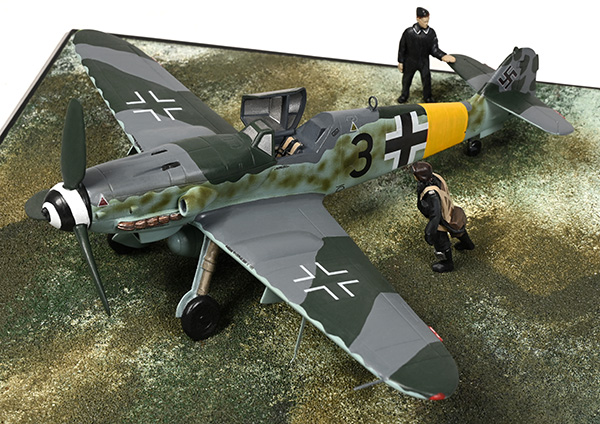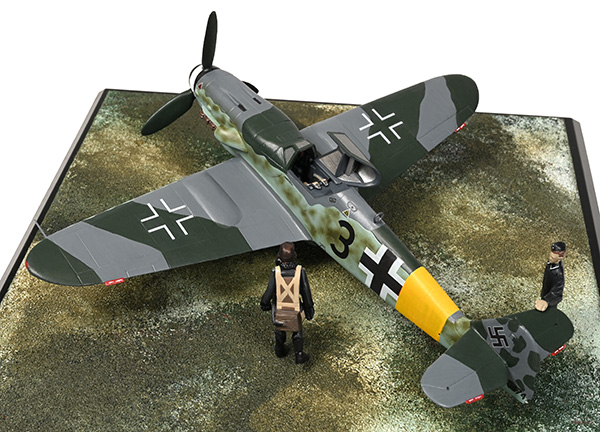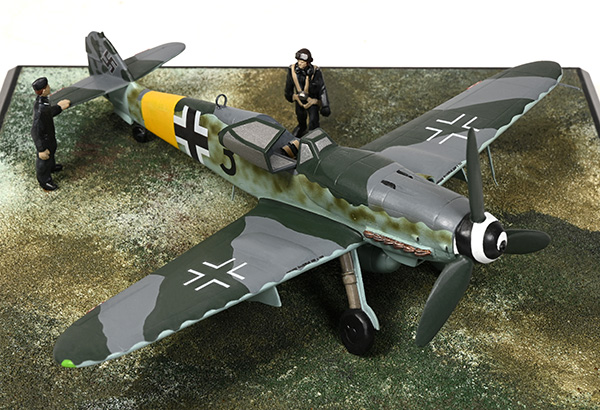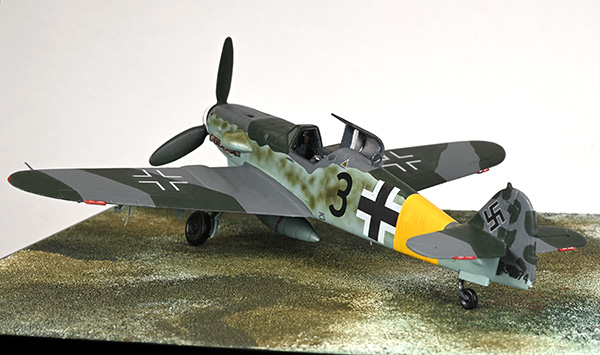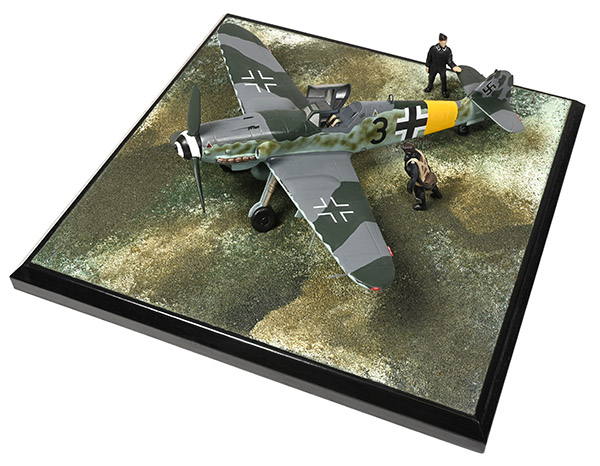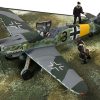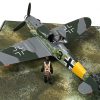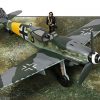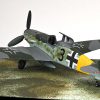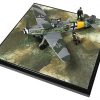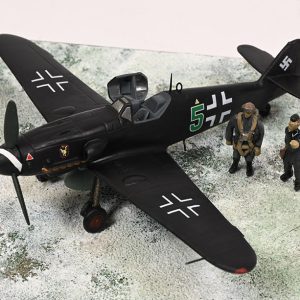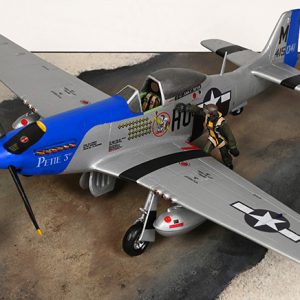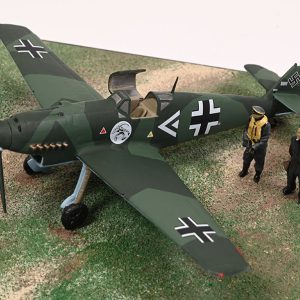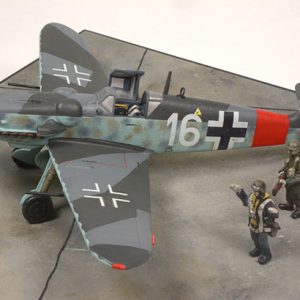Messerschmitt Bf 109K-4
“Black 3” Wk Nr 330474 of 6./JG 11
flown by Fahenjunker Unteroffizier Herbert Huss,
Maastricht, January 1st 1945.
The Bf 109K was the last of the series to see operational duty and the last in the Bf 109 evolutionary line. The K series was a response to the bewildering array of series, models, modification kits and factory conversions for the Bf 109, which made production and maintenance complicated and costly – something Germany could not afford late in the war. The RLM ordered Messerschmitt to rationalise production of the Bf 109, consolidating parts and types to produce a standard model with more interchangeable parts and equipment; flaws in the design of the airframe were also to be remedied. Work on the new version began in the spring of 1943 and the prototype was ready by autumn. Series production started in August 1944 with the K-4 model, due to changes in the design and delays with the new DB 605D power-plant. The K-4 was the only version to be mass-produced.
Externally the K series could be identified by changes in the locations of the radio equipment hatch, which was moved forward and to a higher position between frames four and five and the filler point for the fuselage fuel tank, which was moved forward to a location between frames two and three. The D/F loop was moved aft to sit between frames three and four on the fuselage spine and a small circular plate above the footstep on the port side of the fuselage was deleted. The rudder was fitted as standard with a Flettner tab and two fixed tabs although some rare examples were not fitted with the fixed tabs. All K-4s were to be fitted with a long retractable tail wheel with two small clamshell doors covering the recess when the tail-wheel was retracted.
The wings featured the large rectangular fairings for the new larger main wheels. Small wheel well doors, originally planned for the G series, were fitted to the outer ends of the wheel bays, covering the outer wheels when retracted. These doors were often removed by front-line units.
Armament of the K-4 consisted of a 30 mm MK 108 engine-mounted cannon (Motorkanone) with 65 rounds and two 13 mm (MG 131s in the nose with 300 rpg, Power was provided in production K-4s by a Daimler-Benz DB 605 DB/DC engine. A wide-chord, three-bladed VDM 9-12159A propeller of 3 m (9.8 ft) diameter was used, as on the G-6/AS, G-14/AS and G-10. Using MW 50 and maximum boost the Bf 109 K-4 was the fastest 109 of World War II, reaching a maximum speed of 710 km/h (440 mph) at 7,500 m (24,600 ft) altitude.
Deliveries began in mid-October 1944 and 534 examples had been delivered by the Messerschmitt A.G., Regensburg by the end of November and 856 by the end of the year. Regensburg delivered a total of 1,593 by the end of March 1945, Ultimately it was intended to equip all Bf 109 units with the 109K, which marked the final stage of 109 development before the jet age.
The Bf 109 remained comparable to opposing fighters until the end of the war but the deteriorating quality of the thousands of novice Luftwaffe pilots pressed into service by this stage of the war meant the 109’s strengths were of little value against the numerous and well-trained Allied fighter pilots.
Operation Bodenplatte (Baseplate) was launched on 1 January 1945. It was an attempt by the Luftwaffe to cripple the enemy air forces in the Low Countries by attacking 17 allied airfields. The goal of Bodenplatte was to gain air superiority during the stagnant stage of the Battle of the Bulge so that the German Army and Waffen-SS forces could resume their advance. The operation was planned for 16 December 1944, but was delayed repeatedly due to bad weather until New Year’s Day, the first day that happened to be suitable.
The Asch Airfield (Designated: Y-29) was home to the 352nd and 366th Fighter Groups. Jagdgeschwader 11 (JG 11) was to destroy the airfield. 41 Fw 190s and 20 Bf 109s pulled together from a variety of Staffels took part in the attack. High levels of attrition and the lack of experienced aircrew led to the numbers being made up with many novice pilots such as Unteroffizier Herbert Huss, himself a cadet pilot.
The plan called for a low-level strike by I and III./JG 11, while II./JG 11 flew as top cover against USAAF fighters. The pilots were shown maps and photographs of the airfield, but were not told the targets’ identity until the morning of the attack. After crossing Allied lines, four fighters were lost to AAA fire. The course of JG 11 took it directly over Ophoven. Large formations of JG 11 attacked, in the mistaken belief it was Asch. The other half continued to Asch. Ophoven housed No. 125 Wing RAF, just 3.1 miles north of Asch. About half, or some 30 Fw 190s and Bf 109s attacked the airfield.
Asch was notable for a chance event. The 390th Squadron of the 366th Fighter Group had launched two fighter sweeps that morning, which played a crucial role in the failure of JG 11’s attack. The leader of the 487th squadron, 352nd Fighter Group, John Charles Meyer, anticipated German activity and had a flight of 12 P-51s about to take off on a combat patrol when the attack began.
Luftwaffe records indicate JG 11 lost 28 fighters. Four German pilots (two wounded) made it back to German-held territory, while four were captured and the remaining twenty were killed. German ace Günther Specht was among those German pilots killed.
The Bf 109K-4 of Fahenjunker Unteroffizier Herbert Huss was hit by anti-aircraft fire and Huss immediately bailed out. Landing near Maastricht he hid in some woods, but was soon spotted by farmers and turned over to the British. The battle over Asch had lasted 45 minutes. The air battle over Asch also came to be known as, ‘The Legend of Y-29’, and encapsulated the failure of Operation Bodenplatte as a whole.
Post-battle analysis suggests only 11 of the Luftwaffe’s 34 air combat Gruppen (groups) made attacks on time and with surprise. The operation failed to achieve air superiority, even temporarily, while the German ground forces continued to be exposed to Allied air attack. Bodenplatte was the last large-scale strategic offensive operation mounted by the Luftwaffe during the war.


